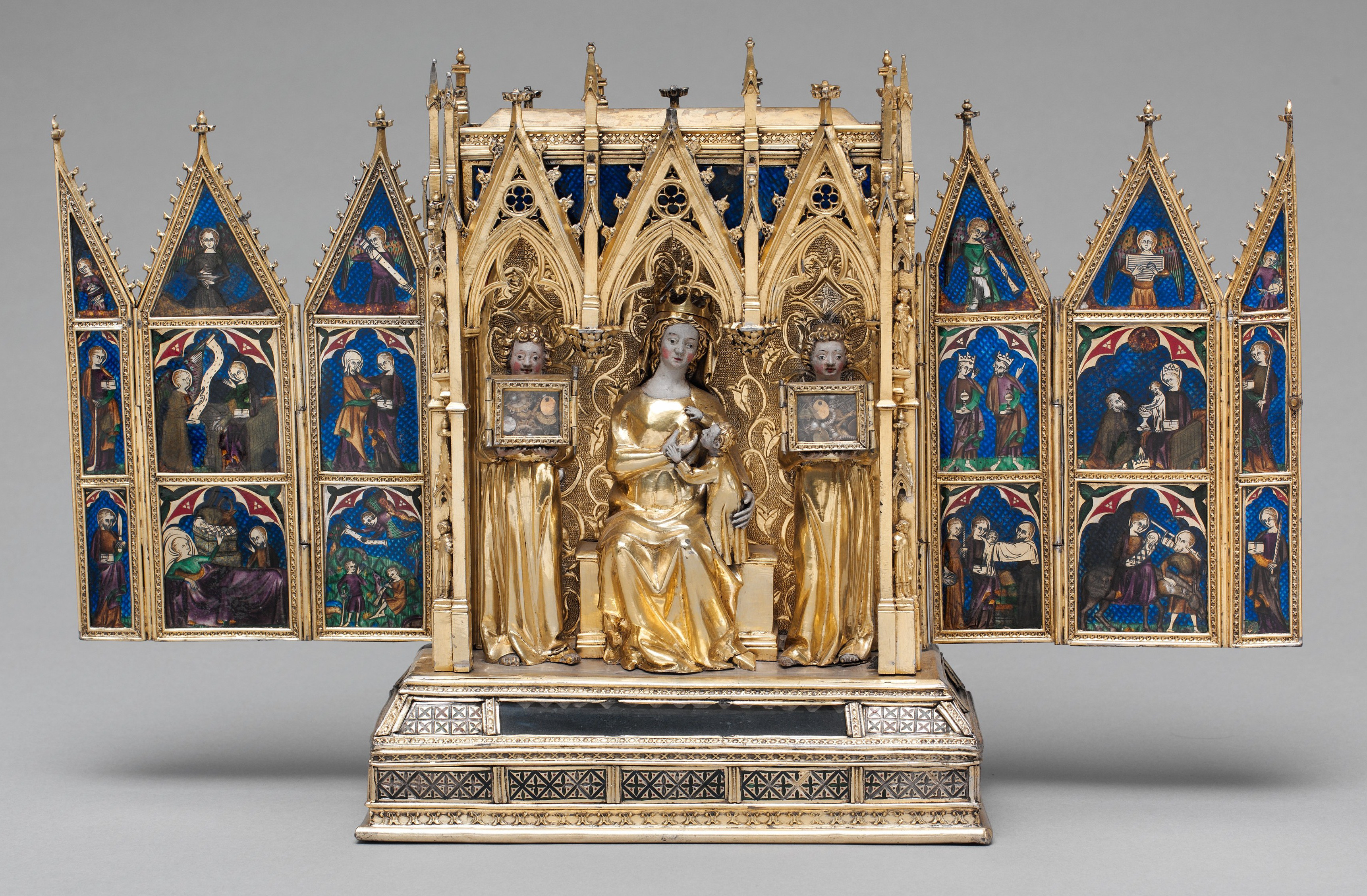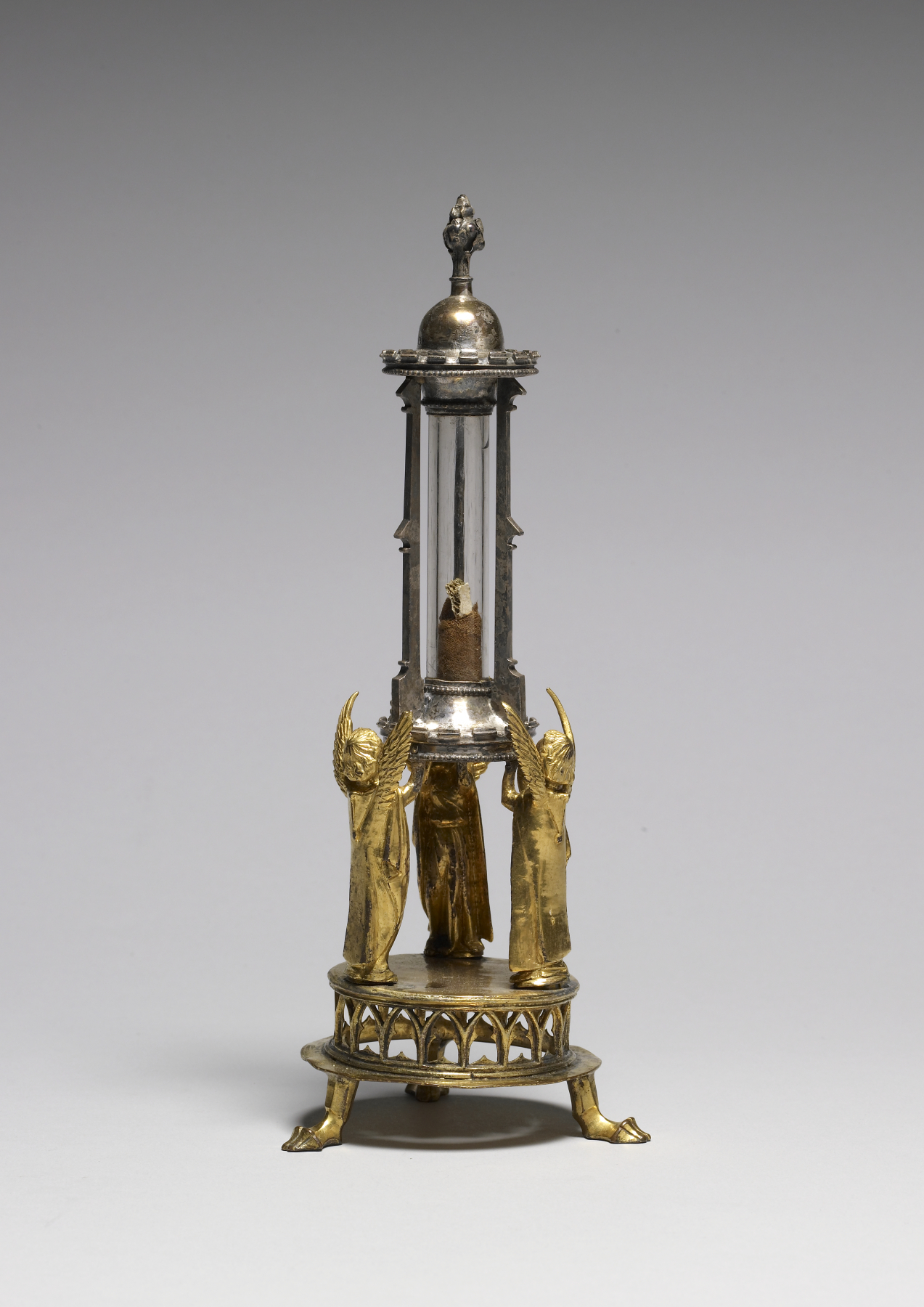|
Becket Casket
The Becket Casket is a reliquary made in about 1180–90 in Limoges, France, and depicts one of the most infamous events in English history, the murder of Archbishop Thomas Becket. Following the assassination, relics of St Thomas were placed in similar reliquaries and dispersed across the world. This 'chasse' shaped reliquary is made of gilt-copper round a wooden core, intricately decorated with champlevé enamel to tell the story of Thomas Becket through literal and symbolic imagery. An exemplary showcasing of the Limoges enamel technique, this reliquary is now located in the Victoria and Albert Museum in London, England. History Becket Assassination On the night of December 29, 1170, Archbishop Thomas Becket was assassinated in Canterbury Cathedral by four knights acting on the orders of King Henry II. This event sparked widespread indignation across Europe, leading to a surge of pilgrims visiting Canterbury to pay their respects at the scene of the murder. In 1173 ... [...More Info...] [...Related Items...] OR: [Wikipedia] [Google] [Baidu] |
Reliquary Thomas Becket MNMA Cl23296
A reliquary (also referred to as a ''shrine'', ''chasse'', or ''phylactery'') is a container for relics. A portable reliquary, or the room in which one is stored, may also be called a ''feretory''. Relics may be the purported or actual physical remains of saints, and may comprise bones, pieces of clothing, or some object associated with saints or with other religious figures. The authenticity of any given relic is often a matter of debate; for that reason, some churches require documentation of a relic's provenance. Relics have long been important to Buddhists, Christians, Hindus, and to followers of many other religions. These cultures often display reliquaries in shrines, churches, or temples to which the faithful make pilgrimages to gain blessings. The term is sometimes used in a looser sense to mean a container for the remains of any important figure, even non-religious ones. In particular, the kings of France often specified that their hearts and sometimes other organs ... [...More Info...] [...Related Items...] OR: [Wikipedia] [Google] [Baidu] |
Burrell Collection
The Burrell Collection is a museum in Glasgow, Scotland, managed by Glasgow Museums. It houses the art collection of William Burrell, Sir William Burrell and Constance Burrell, Constance, Lady Burrell. The museum opened in 1983 and reopened on 29 March 2022 following a major refurbishment. It was announced as the winner of the Art Fund Museum of the Year in July 2023. It is the only non-national museum to be the outright winner twice. History The eclectic collection was acquired over many years by William Burrell, Sir William Burrell, a wealthy Glasgow shipping magnate and art collector, and his wife Constance, Lady Burrell, who then gave it to the city of Glasgow Corporation in 1944. Throughout his collecting career, Burrell lent many of the works in his collection to special exhibitions and for display in museums. Sometime , he decided that he was going to donate his entire collection to the public. Burrell then began the process of finding a home for the remaining 6,000 ite ... [...More Info...] [...Related Items...] OR: [Wikipedia] [Google] [Baidu] |
Frit
A frit is a ceramic composition that has been fused, quenched, and granulated. Frits form an important part of the batches used in compounding enamels and ceramic glazes; the purpose of this pre-fusion is to render any soluble and/or toxic components insoluble by causing them to combine with silica and other added oxides.''Dictionary of Ceramics'' (3rd Edition) Edited by Dodd, A. Murfin, D. Institute of Materials. 1994. However, not all glass that is fused and quenched in water is frit, as this method of cooling down very hot glass is also widely used in glass manufacture. According to the '' OED'', the origin of the word "frit" dates back to 1662 and is "a calcinated mixture of sand and fluxes ready to be melted in a crucible to make glass". Nowadays, the unheated raw materials of glass making are more commonly called "glass batch". In antiquity, frit could be crushed to make pigments or shaped to create objects. It may also have served as an intermediate material in the manu ... [...More Info...] [...Related Items...] OR: [Wikipedia] [Google] [Baidu] |
Pyx Palmettes MNMA Cl964c
A pyx or pix (, transliteration of Greek: ''πυξίς'', boxwood receptacle, from ''πύξος'', box tree) is a small round container used in the Catholic, Old Catholic, Lutheran and Anglican Churches to carry the Eucharist, to the sick or those who are otherwise unable to come to a church in order to receive Holy Communion. The term can also be used in archaeology and art history to describe small, round lidded boxes designed for any purpose from antiquity or the Middle Ages, such as those used to hold coins for the Trial of the Pyx in England. Usage The word ''pyx'' comes from the Greek word πυξίς, ''pyxis'' 'box, receptacle'. (The Greek-like plural, ', has given way to ' in English.) While the word may be applied to any covered carrier, in modern usage the term "pyx" usually denotes a small, flat, clamshell-style container, often about the size of a pocket watch and usually made of brass or other metals, traditionally lined with gold. A fabric or leather pouch for ca ... [...More Info...] [...Related Items...] OR: [Wikipedia] [Google] [Baidu] |
Quatrefoil
A quatrefoil (anciently caterfoil) is a decorative element consisting of a symmetrical shape which forms the overall outline of four partially overlapping circles of the same diameter. It is found in art, architecture, heraldry and traditional Christian symbolism. The word 'quatrefoil' means "four leaves", from the Latin , "four", plus , "leaf"; the term refers specifically to a four-leafed clover, but applies in general to four-lobed shapes in various contexts. In recent years, several luxury brands have attempted to fraudulently assert creative rights related to the symbol, which naturally predates any of those brands' creative development. A similar shape with three rings is called a trefoil, while a shape with five is a cinquefoil. History The quatrefoil enjoyed its peak popularity during the Gothic architecture, Gothic and Renaissance eras. It is most commonly found as tracery, mainly in Gothic architecture, where a quatrefoil often may be seen at the top of a Gothic arch, ... [...More Info...] [...Related Items...] OR: [Wikipedia] [Google] [Baidu] |
Cardinal Virtues
The cardinal virtues are four virtues of mind and character in classical philosophy. They are prudence, Justice (virtue), justice, Courage, fortitude, and Temperance (virtue), temperance. They form a Virtue ethics, virtue theory of ethics. The term ''cardinal'' comes from the Latin (hinge); these four virtues are called "cardinal" because all other virtues fall under them and hinge upon them. These virtues derive initially from Plato in ''The Republic (Plato), Republic'' Book IV, 426-435. Aristotle expounded them systematically in the ''Nicomachean Ethics''. They were also recognized by the Stoicism, Stoics and Cicero expanded on them. In the Christian tradition, they are also listed in the Deuterocanonical books in and , and the Doctor of the Church, Doctors Ambrose, Augustine of Hippo, Augustine, and Thomas Aquinas, Aquinas expounded their supernatural counterparts, the three theological virtues of faith, hope, and charity. Four cardinal virtues * Prudence (, Phronesis, ; ... [...More Info...] [...Related Items...] OR: [Wikipedia] [Google] [Baidu] |
Figure Des Quatre Vertus From Ballet Comique De La Reine
Figure may refer to: General *A shape, drawing, depiction, or geometric configuration *Figure (wood), wood appearance *Figure (music), distinguished from musical motif *Noise figure, in telecommunication *Dance figure, an elementary dance pattern *A person's figure, human physical appearance *Figure–ground (perception), the distinction between a visually perceived object and its surroundings Arts *Figurine, a miniature statuette representation of a creature *Action figure, a posable jointed solid plastic character figurine *Figure painting, realistic representation, especially of the human form *Figure drawing *Model figure, a scale model of a creature Writing *figure, in writing, a type of floating block (text, table, or graphic separate from the main text) *Figure of speech, also called a rhetorical figure *Christ figure, a type of character * in typesetting, text figures and lining figures Accounting *Figure, a synonym for number *Significant figures in a decimal number ... [...More Info...] [...Related Items...] OR: [Wikipedia] [Google] [Baidu] |
Saint Peter
Saint Peter (born Shimon Bar Yonah; 1 BC – AD 64/68), also known as Peter the Apostle, Simon Peter, Simeon, Simon, or Cephas, was one of the Twelve Apostles of Jesus and one of the first leaders of the Jewish Christian#Jerusalem ekklēsia, early Christian Church. He appears repeatedly and prominently in Gospel#Canonical gospels, all four New Testament gospels, as well as the Acts of the Apostles. Catholic Church, Catholic and Eastern Orthodoxy, Orthodox tradition treats Peter as the first bishop of Rome – or List of popes, pope – and also as the first bishop of Antioch. Peter's History of the papacy, leadership of the early believers is estimated to have spanned from AD 30 or 33 to his death; these dates suggest that he could have been the longest-reigning pope, for anywhere from 31 to 38 years; however, this has never been verified. According to Apostolic Age, Christian tradition, Peter was crucified in Rome under Emperor Nero. The ancient Christian churches all venera ... [...More Info...] [...Related Items...] OR: [Wikipedia] [Google] [Baidu] |
Christ In Majesty
Christ in Majesty or Christ in Glory () is the Western Christian image of Christ seated on a throne as ruler of the world, always seen frontally in the centre of the composition, and often flanked by other sacred figures, whose membership changes over time and according to the context. The image develops from Early Christian art, as a depiction of the Heavenly throne as described in 1 Enoch, Daniel 7, and The Apocalypse of John. In the Byzantine world, the image developed slightly differently into the half-length Christ Pantocrator, "Christ, Ruler of All", a usually unaccompanied figure, and the Deesis, where a full-length enthroned Christ is entreated by Mary and St. John the Baptist, and often other figures. In the West, the evolving composition remains very consistent within each period until the Renaissance, and then remains important until the end of the Baroque, in which the image is ordinarily transported to the sky. Development From the latter part of the fourth cen ... [...More Info...] [...Related Items...] OR: [Wikipedia] [Google] [Baidu] |
Reliquary Casket With Scenes From The Martyrdom Of Saint Thomas Becket MET Sf17-190-520s1
A reliquary (also referred to as a ''shrine'', ''chasse'', or ''phylactery'') is a container for relics. A portable reliquary, or the room in which one is stored, may also be called a ''feretory''. Relics may be the purported or actual physical remains of saints, and may comprise bones, pieces of clothing, or some object associated with saints or with other religious figures. The authenticity of any given relic is often a matter of debate; for that reason, some churches require documentation of a relic's provenance. Relics have long been important to Buddhists, Christians, Hindus, and to followers of many other religions. These cultures often display reliquaries in shrines, churches, or temples to which the faithful make pilgrimages to gain blessings. The term is sometimes used in a looser sense to mean a container for the remains of any important figure, even non-religious ones. In particular, the kings of France often specified that their hearts and sometimes other organs ... [...More Info...] [...Related Items...] OR: [Wikipedia] [Google] [Baidu] |
Byzantine Art
Byzantine art comprises the body of artistic products of the Eastern Roman Empire, as well as the nations and states that inherited culturally from the empire. Though the empire itself emerged from the decline of Rome, decline of western Rome and lasted until the Fall of Constantinople in 1453, the start date of the Byzantine period is rather clearer in art history than in political history, if still imprecise. Many Eastern Orthodox states in Eastern Europe, as well as to some degree the Islamic states of the eastern Mediterranean, preserved many aspects of the empire's culture and art for centuries afterward. A number of contemporary states with the Eastern Roman (Byzantine) Empire were culturally influenced by it without actually being part of it (the "Byzantine commonwealth"). These included Kievan Rus', as well as some non-Orthodox states like the Republic of Venice, which separated from the Byzantine Empire in the 10th century, and the Norman-Arab-Byzantine culture, Kingdom o ... [...More Info...] [...Related Items...] OR: [Wikipedia] [Google] [Baidu] |
Romanesque Art
Romanesque art is the art of Europe from approximately 1000 AD to the rise of the Gothic Art, Gothic style in the 12th century, or later depending on region. The preceding period is known as the Pre-Romanesque period. The term was invented by 19th-century art historians, especially for Romanesque architecture, which retained many basic features of Roman architecture, Roman architectural style – most notably round-headed arches, but also barrel vaults, apses, and Acanthus (ornament), acanthus-leaf decoration – but had also developed many very different characteristics. In Southern France, Spain, and Italy there was an architectural continuity with the Late Antique, but the Romanesque style was the first style to spread across the whole of Catholic Europe, from Sicily to Scandinavia. Romanesque art was also greatly influenced by Byzantine art, especially in painting, and by the anti-classical energy of the decoration of the Insular art of the British Isles. From these element ... [...More Info...] [...Related Items...] OR: [Wikipedia] [Google] [Baidu] |







